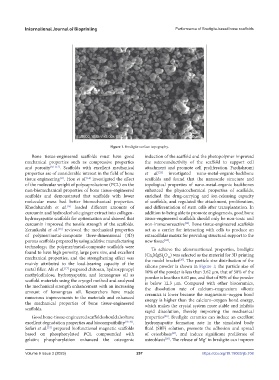Page 265 - IJB-9-3
P. 265
International Journal of Bioprinting Performance of Bredigite-based bone scaffolds
Figure 1. Bredigite surface topography.
Bone tissue-engineered scaffolds must have good induction of the scaffold and the photopolymer improved
mechanical properties such as compressive properties the osteoconductivity of the scaffold to support cell
and porosity [9,11,12] . Scaffolds with excellent mechanical attachment and promote cell proliferation. Fardjahromi
properties are of considerable interest in the field of bone et al. investigated nano-metal-organic-backbone
[22]
tissue engineering . Hou et al. investigated the effect scaffolds and found that the nanoscale structure and
[13]
[14]
of the molecular weight of polycaprolactone (PCL) on the topological properties of nano-metal-organic backbones
non-biomechanical properties of bone tissue-engineered enhanced the physicochemical properties of scaffolds,
scaffolds and demonstrated that scaffolds with lower enriched the drug-carrying and ion-releasing capacity
molecular mass had better biomechanical properties. of scaffolds, and regulated the attachment, proliferation,
Khodabandeh et al. loaded different amounts of and differentiation of stem cells after transplantation. In
[15]
curcumin and hydroalcoholic ginger extract into collagen- addition to being able to promote angiogenesis, good bone
hydroxyapatite scaffolds for optimization and showed that tissue-engineered scaffolds should only be non-toxic and
curcumin improved the tensile strength of the scaffolds. non-immunoreactive . Bone tissue-engineered scaffolds
[23]
[16]
Zerankeshi et al. reviewed the mechanical properties act as a carrier for interacting with cells to produce an
of polymer/metal-composite three-dimensional (3D) extracellular matrix for providing structural support to the
[24]
porous scaffolds prepared by using additive manufacturing new tissue .
technology; the polymer/metal-composite scaffolds were To achieve the aforementioned properties, bredigite
found to have high porosity, large pore size, and excellent (Ca MgSi O ) was selected as the material for 3D printing
mechanical properties, and the strengthening effect was the model bracket . The particle size distribution of the
4
7
16
[25]
mainly attributed to the load-bearing capacity of the silicate powder is shown in Figure 1; the particle size of
metal filler. Ali et al. prepared chitosan, hydroxypropyl 10% of the powder is less than 3.62 μm, that of 50% of the
[17]
methylcellulose, hydroxyapatite, and lemongrass oil as powder is less than 6.60 μm, and that of 90% of the powder
scaffold materials using the cryogel method and analyzed is below 12.3 μm. Compared with other bioceramics,
the mechanical strength enhancement with an increasing the dissolution rate of calcium–magnesium silicate
amount of lemongrass oil. Researchers have made ceramics is lower because the magnesium–oxygen bond
numerous improvements to the materials and enhanced energy is higher than the calcium–oxygen bond energy,
the mechanical properties of bone tissue-engineered which makes the crystal system more stable and inhibits
scaffolds. rapid dissolution, thereby improving the mechanical
Good bone-tissue-engineered scaffolds should also have properties . Bredigite ceramics can induce an excellent
[26]
excellent degradation properties and biocompatibility [18-20] . hydroxyapatite formation rate in the simulated body
Safari et al. prepared biofunctional magnetic scaffolds fluid (SBF) solution, promote the adhesion and spread
[21]
based on phosphorylated PCL compounded with of osteoblasts , and induce significant proliferate of
[27]
gelatin; phosphorylation enhanced the osteogenic osteoblasts . The release of Mg in bredigite can improve
[28]
+
Volume 9 Issue 3 (2023) 257 https://doi.org/10.18063/ijb.708

